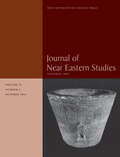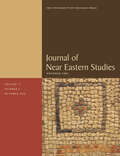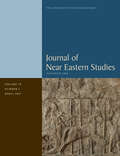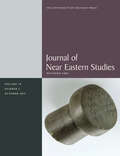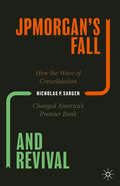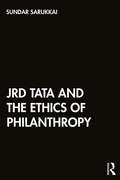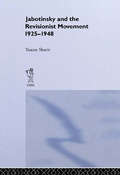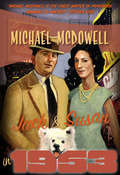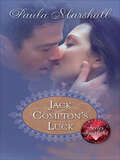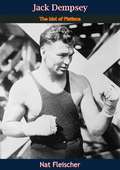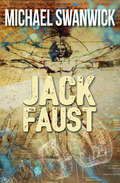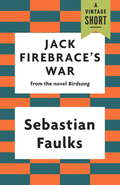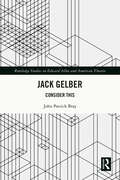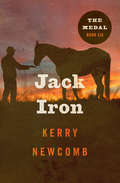- Table View
- List View
JNES vol 75 num 2
by The University of Chicago PressThis is volume 75 issue 2 of Journal of Near Eastern Studies. The Journal of Near Eastern Studies (JNES) is devoted to the study of the civilizations of the Near East from prehistory to the early modern period in 1922. JNES embraces a uniquely broad scope of time, place, and topic, including contributions from scholars of international reputation on topics in Assyriology, Egyptology, Hittitology, Hebrew Bible, and adjacent ancient studies, as well as a second area of emphasis in early, medieval, and early-modern Islamic studies. The disciplinary range of the journal runs from history and language to religion and literature to archaeology and art history. Every issue includes new scholarly work as well as a book review section, which provides a critical overview of new publications by emerging and established scholars.
JNES vol 76 num 1
by The University of Chicago PressThis is volume 76 issue 1 of Journal of Near Eastern Studies. The Journal of Near Eastern Studies (JNES) is devoted to the study of the civilizations of the Near East from prehistory to the early modern period in 1922. JNES embraces a uniquely broad scope of time, place, and topic, including contributions from scholars of international reputation on topics in Assyriology, Egyptology, Hittitology, Hebrew Bible, and adjacent ancient studies, as well as a second area of emphasis in early, medieval, and early-modern Islamic studies. The disciplinary range of the journal runs from history and language to religion and literature to archaeology and art history. Every issue includes new scholarly work as well as a book review section, which provides a critical overview of new publications by emerging and established scholars.
JNES vol 77 num 2
by The University of Chicago PressThis is volume 77 issue 2 of Journal of Near Eastern Studies. The Journal of Near Eastern Studies (JNES) is devoted to the study of the civilizations of the Near East from prehistory to the early modern period in 1922. JNES embraces a uniquely broad scope of time, place, and topic, including contributions from scholars of international reputation on topics in Assyriology, Egyptology, Hittitology, Hebrew Bible, and adjacent ancient studies, as well as a second area of emphasis in early, medieval, and early-modern Islamic studies. The disciplinary range of the journal runs from history and language to religion and literature to archaeology and art history. Every issue includes new scholarly work as well as a book review section, which provides a critical overview of new publications by emerging and established scholars.
JNES vol 78 num 1
by The University of Chicago PressThis is volume 78 issue 1 of Journal of Near Eastern Studies. The Journal of Near Eastern Studies (JNES) is devoted to the study of the civilizations of the Near East from prehistory to the early modern period in 1922. JNES embraces a uniquely broad scope of time, place, and topic, including contributions from scholars of international reputation on topics in Assyriology, Egyptology, Hittitology, Hebrew Bible, and adjacent ancient studies, as well as a second area of emphasis in early, medieval, and early-modern Islamic studies. The disciplinary range of the journal runs from history and language to religion and literature to archaeology and art history. Every issue includes new scholarly work as well as a book review section, which provides a critical overview of new publications by emerging and established scholars.
JNES vol 78 num 2
by The University of Chicago PressThis is volume 78 issue 2 of Journal of Near Eastern Studies. The Journal of Near Eastern Studies (JNES) is devoted to the study of the civilizations of the Near East from prehistory to the early modern period in 1922. JNES embraces a uniquely broad scope of time, place, and topic, including contributions from scholars of international reputation on topics in Assyriology, Egyptology, Hittitology, Hebrew Bible, and adjacent ancient studies, as well as a second area of emphasis in early, medieval, and early-modern Islamic studies. The disciplinary range of the journal runs from history and language to religion and literature to archaeology and art history. Every issue includes new scholarly work as well as a book review section, which provides a critical overview of new publications by emerging and established scholars.
JNES vol 79 num 2
by The University of Chicago PressThis is volume 79 issue 2 of Journal of Near Eastern Studies. The Journal of Near Eastern Studies (JNES) is devoted to the study of the civilizations of the Near East from prehistory to the early modern period in 1922. JNES embraces a uniquely broad scope of time, place, and topic, including contributions from scholars of international reputation on topics in Assyriology, Egyptology, Hittitology, Hebrew Bible, and adjacent ancient studies, as well as a second area of emphasis in early, medieval, and early-modern Islamic studies. The disciplinary range of the journal runs from history and language to religion and literature to archaeology and art history. Every issue includes new scholarly work as well as a book review section, which provides a critical overview of new publications by emerging and established scholars.
JOE FOSS, FLYING MARINE - The Story Of His Flying Circus As Told To Walter Simmons [Illustrated Edition]
by Colonel Joseph "Joe" Foss U.S.M.C. Walter SimmonsIllustrated with 22 photos of the Author, his unit and his life.The top American Fighter Ace of World War Two recounts his experiences, combats and victories in the skies above the Pacific. His citation for the Congressional Medal of Honour gives the bare unadorned facts about the eagle-eyed flyer from Sioux Falls, South Dakota;"For outstanding heroism and courage above and beyond the call of duty as executive officer of Marine Fighting Squadron 121, 1st Marine Aircraft Wing, at Guadalcanal. Engaging in almost daily combat with the enemy from 9 October to 19 November 1942, Captain Foss personally shot down 23 Japanese planes and damaged others so severely that their destruction was extremely probable. In addition, during this period, he successfully led a large number of escort missions, skillfully covering reconnaissance, bombing, and photographic planes as well as surface craft. On 15 January 1943, he added 3 more enemy planes to his already brilliant successes for a record of aerial combat achievement unsurpassed in this war. Boldly searching out an approaching enemy force on 25 January, Captain Foss led his 8 F-4F Marine planes and 4 Army P-38's into action and, undaunted by tremendously superior numbers, intercepted and struck with such force that 4 Japanese fighters were shot down and the bombers were turned back without releasing a single bomb. His remarkable flying skill, inspiring leadership, and indomitable fighting spirit were distinctive factors in the defense of strategic American positions on Guadalcanal."One of the most thrilling combat memoirs written of World War Two. Highly recommended.
JPMorgan’s Fall and Revival: How the Wave of Consolidation Changed America’s Premier Bank
by Nicholas P. SargenThis book tells the untold story of how JPMorgan became a universal bank in the 1980s-1990s and the events leading to it being acquired by Chase in 2000. It depicts the challenges Morgan’s leaders – Lew Preston and Dennis Weatherstone – confronted when the firm’s business model was disrupted by the developing country debt crisis and premier corporate borrowers increasingly accessing capital markets, up to its current management with Jamie Dimon. It depicts what happened to Morgan in the larger story of U.S. banking consolidation.As Morgan sought to re-enter the world of securities and navigate around Glass-Steagall barriers, their overriding goal was to ensure it would remain a pre-eminent wholesale bank serving multinational corporations. Opportunities to grow through acquisition were presented and considered, including purchasing a stake in Citibank in the early 1990s. However, Preston and Weatherstone were reluctant to integrate areas unfamiliar to Morgan such as retail banking or to assimilate cultures that were disparate from the firm’s.This first-hand account explores whether Morgan could have stayed independent had its leaders pursued the strategic plan that called for it to make targeted acquisitions in areas where it had well-established businesses. Instead, in the mid-1990s, it went from being the hunter to the hunted. Rival banks that had been burdened by bad loans to developing countries and commercial real estate capitalized on rising share prices during the tech boom to acquire other institutions. Meanwhile, Morgan’s profits and share price lagged, which left it vulnerable.During this time, all of the leading financial institutions struggled to change their business models. In the end, no U.S. money center bank was able to become a universal bank on its own. What ensued was a growing concentration of financial assets in a handful of institutions that was the precursor to the 2008 financial crisis, which is explored further using Morgan as a lens, in a book that is sure to interest banking and Wall Street professionals and business readers alike.
JPS: The Americanization of Jewish Culture, 1888–1988 (Philip and Muriel Berman Edition)
by Jonathan D. SarnaPublished to mark the 100th anniversary of The Jewish Publication Society, Jonathan Sarna’s engaging blend of anecdote and analysis presents the personalities and the controversies, the struggles and the achievements behind a century of publishing by the oldest English-language publisher of Jewish books in the world. Includes black and white photographs and extensive listings of JPS officers and editors, governing boards, and authors, translators, and illustrators, up to 1988.
JRD Tata and the Ethics of Philanthropy
by Sundar SarukkaiThis book introduces readers to the ethics of philanthropy, particularly in the Indian context. Drawing on JRD Tata’s philosophy and approach to business, it shows how business and philanthropy were intrinsically related for him. JRD Tata was arguably one of the most influential businessmen in post-Independence India. He was instrumental in not only expanding the Tata businesses but was also known for his impact on the conduct of business as well as his support for various national projects including research and education. He introduced key labour laws in his factories, which later became the model for the Indian government. He was also part of government institutions such as Air India. By discussing ideas such as trusteeship, the notion of profit, the relation between public and private, and social welfare, the book offers an intellectual map of JRD’s thoughts and an original perspective on their significance for an ethics of philanthropy in general. It provides new insights into the nature of ethical problems in the Indian context as well as ways to negotiate with them based on JRD’s work and reflections. It further creates a more meaningful understanding of Corporate Social Responsibility in the present global economy. Lucid and comprehensive, this book will be useful to scholars, researchers and faculty in departments of management and business studies, social work, sociology, economics and philosophy, as well as across social sciences. It will be of great interest to philanthropy organisations, non-governmental organisations, business schools, industry bodies, corporates, and those in leadership and management.
Jabotinsky and the Revisionist Movement 1925-1948
by Yaacov ShavitFirst published in 1988. The focus of this title, the nature and character of the Israeli political Right, gained intensive interest immediately after the Israeli elections of 1977. The author discusses this shift of political power from the Left to the Right as a profound political upheaval and discusses this alongside the prior Labour hegemony of the Yishuv. This book is separated into four parts: The territory and organisation of the right; The intellectual foundation of the right; Ideology, programme and political methods and Contradictory images.
Jabotinsky's Children: Polish Jews and the Rise of Right-Wing Zionism
by Daniel Kupfert HellerHow interwar Poland and its Jewish youth were instrumental in shaping the ideology of right-wing ZionismBy the late 1930s, as many as fifty thousand Polish Jews belonged to Betar, a youth movement known for its support of Vladimir Jabotinsky, the founder of right-wing Zionism. Poland was not only home to Jabotinsky’s largest following. The country also served as an inspiration and incubator for the development of right-wing Zionist ideas. Jabotinsky’s Children draws on a wealth of rare archival material to uncover how the young people in Betar were instrumental in shaping right-wing Zionist attitudes about the roles that authoritarianism and military force could play in the quest to build and maintain a Jewish state.Recovering the voices of ordinary Betar members through their letters, diaries, and autobiographies, Jabotinsky’s Children paints a vivid portrait of young Polish Jews and their turbulent lives on the eve of the Holocaust. Rather than define Jabotinsky as a firebrand fascist or steadfast democrat, the book instead reveals how he deliberately delivered multiple and contradictory messages to his young followers, leaving it to them to interpret him as they saw fit. Tracing Betar’s surprising relationship with interwar Poland’s authoritarian government, Jabotinsky’s Children overturns popular misconceptions about Polish-Jewish relations between the two world wars and captures the fervent efforts of Poland’s Jewish youth to determine, on their own terms, who they were, where they belonged, and what their future held in store.Shedding critical light on a vital yet neglected chapter in the history of Zionism, Jabotinsky’s Children provides invaluable perspective on the origins of right-wing Zionist beliefs and their enduring allure in Israel today.
Jack & Susan in 1913 (Jack & Susan #1)
by Michael McDowellIn this unique romance series debut, two timeless young lovers find each other amid the madcap antics of the silent film industry. Regardless of what the calendar says, Jack and Susan are always, eternally, twenty-seven years old. They are destined for each other like Hepburn and Tracy, Dagwood and Blondie, Nick and Nora. And somehow, they always acquire a shaggy white dog on the way to falling in love. In 1913, the world is thrilling to that fabulous invention, the motion picture. When Susan&’s Broadway career is ended by injury, she takes up work writing for a New York studio. And when Jack sees Susan, he&’s willing to do anything—even break into a new business—to get her attention. When the movies move West, Jack and Susan—and their three-legged dog Tripod!—go along with them. But they soon discover that not all of the bad guys are on the silver screen.
Jack & Susan in 1933 (Jack & Susan #2)
by Michael McDowellIn this unique time-shift romance series, two young lovers find each other—once again—as trouble brews in Depression Era New York City. Regardless of what the calendar says, Jack and Susan are always, eternally, twenty-seven years old. They are destined for each other like Hepburn and Tracy, Dagwood and Blondie, Nick and Nora. And somehow, they always acquire a shaggy white dog on the way to falling in love. In 1933, Jack and Susan are both married to the Wrong People. Their respective spouses aren&’t so awful as to inspire homicide, but when one of them turns up dead, Susan becomes the cops&’ favorite suspect. Thank heaven Jack is there—along with his friends, the intrepid Scotty and Zelda—to prevent a terrible miscarriage of justice!
Jack & Susan in 1953 (Jack & Susan #3)
by Michael McDowellIn this time-shift romance series by the screenwriter of Beetlejuice, the timeless lovers are on a daring adventure through 1950s NYC and Havana. Regardless of what the calendar says, Jack and Susan are always, eternally, twenty-seven years old. They are destined for each other like Hepburn and Tracy, Dagwood and Blondie, Nick and Nora. And somehow, they always acquire a shaggy white dog on the way to falling in love. In 1953, New York City is at its glamorous best, Jack&’s engaged to be engaged to a margarine heiress, and Susan&’s got a dark and mysterious suitor. When word arrives that someone is trying to poison Susan&’s long-lost uncle, she and Jack—and his loyal dog Woolf!—head for Havana to rescue uncle James, apprehend the bad guys and hit a few casinos on the side.
Jack 1939
by Francine MathewsIn "one of the most deliciously high-concept thrillers imaginable" (The New Yorker) a young JFK travels to Europe on a secret mission for President Roosevelt It’s the spring of 1939, and the prospect of war in Europe looms large. The United States has no intelligence service. In Washington, D. C. , President Franklin Roosevelt may run for an unprecedented third term and needs someone he can trust to find out what the Nazis are up to. His choice: John F. Kennedy. It’s a surprising selection. At twenty-two, Jack Kennedy is the attractive but unpromising second son of Joseph P. Kennedy, Roosevelt’s ambassador to Britain (and occasional political adversary). But when Jack decides to travel through Europe to gather research for his Harvard senior thesis, Roosevelt takes the opportunity to use him as his personal spy. The president’s goal: to stop the flow of German money that has been flooding the United States to buy the 1940 election—an election that Adolf Hitler intends Roosevelt lose. In a deft mosaic of fact and fiction, Francine Mathews has written a gripping espionage tale that explores what might have happened when a young Jack Kennedy is let loose in Europe as the world careens toward war. A potent combination of history and storytelling, Jack 1939 is a sexy, entertaining read. .
Jack 1939
by Francine MathewsCharming. Reckless. Brilliant. Deadly. A young Jack Kennedy travels to Europe on a secret mission for Franklin Roosevelt as the world braces for war.It's the spring of 1939, and the prospect of war in Europe looms large. The United States has no intelligence service. In Washington, D.C., President Franklin Roosevelt may run for an unprecedented third term and needs someone he can trust to find out what the Nazis are up to. His choice: John F. Kennedy.It's a surprising selection. At twenty-two, Jack Kennedy is the attractive but unpromising second son of Joseph P. Kennedy, Roosevelt's ambassador to Britain (and occasional political adversary). But when Jack decides to travel through Europe to gather research for his Harvard senior thesis, Roosevelt takes the opportunity to use him as his personal spy. The president's goal: to stop the flow of German money that has been flooding the United States to buy the 1940 election--an election that Adolf Hitler intends Roosevelt lose.In a deft mosaic of fact and fiction, Francine Mathews has written a gripping espionage tale that explores what might have happened when a young Jack Kennedy is let loose in Europe as the world careens toward war. A potent combination of history and storytelling, Jack 1939 is a sexy, entertaining read.
Jack Compton's Luck
by Paula MarshallFour years of war and even more years of trying to save the family estate have knocked the daredevil out of Jack Compton. He's hanging on to his place in society by the skin of his teeth.Seeing Lacey Chancellor joyously dancing the Charleston brings his passion for life back full force! As luck would have it, this wealthy heiress is drawn to him. But pride is a powerful thing. Unwilling to be branded a fortune hunter, will Jack choose honor over love?
Jack Daniel's Legacy
by Ben A. GreenLynchburg is famous for whiskey... Jack Daniel Whiskey. But who was this little man? And how did he come to make the finest whiskey in the world? Here's his story: In the rolling hills of Moore County, Tennessee, you will find The Jack Daniel's Distillery. It has been in existence for over 125 years. The area was originally part of Lincoln County where Jasper Newton Daniel (later called "Jack") was born on September 5, 1846, the youngest of 10 children. Jack's mother died when he was just a baby. Several years later his father remarried. Jack never got along with his stepmother and left home at the age of 6 to live with a nearby uncle. As a young boy he was befriended by Dan Call a local minister and storekeeper. He took Jack under his wing and trained him to work in the store. But Jack was not happy working there. He had a keen interest in the "still house" which was located on the property. Making whiskey at that time in that area was an acceptable practice though it was never consumed on Sundays. Dan promised Jack he could come to the still house whenever he wanted and he would teach him the art of making the world's best whiskey... made the Lincoln County way. In 1861, the war came to Lincoln County. Jack was too young to serve so remained as an apprentice to Dan Call, learning the sour mash method and perfecting the unique method known as the "Lincoln County Process." In 1863 after hearing a fiery sermon on the evils of alcohol, Dan Call's wife, along with their entire congregation, called on Dan to make "a serious decision regarding being a minister and operating a distillery." Rev. Call decided to sell his business to his young apprentice, Jack Daniel. Upon hearing of the availability of a particular piece of land near Lynchburg, Jack moved his operation there. This area contained the perfect situation for brewing excellent quality whiskey: the pure spring water from the limestone cave and the sugar maple trees that grew in abundance nearby. The War Between the States was over and Jack realized the Federal government would soon be taxing his products. Thinking ahead, Jack at the age of 16, took the step of being the first distillery to register with the United States government. You will see to this day the words "Oldest registered distillery in the US" on every Jack Daniel's label. The secret of the Lincoln County Process is based on the tedious filtering of the whiskey through charcoal produced by the sugar maple tree and, of course, the wonderful pure spring water. No chemicals are used in this natural fermentation process. In 1904 Jack secretly entered his brew in the St. Louis World's Fair. He completed with older, more established products from Europe. Amazingly, he won the Gold Medal for the Best Whiskey in the World! In 1905 he won another prestigious award in Belgium. He now had customers around the world and Jack Daniel Whiskey was famous! He continued running the successful business until a freak accident ended it all. One day, in frustration, he kicked a safe in his office, which wouldn't open and crushed his toe. It later became gangrenous and his health declined during the next 6 years leading to his death in 1911. Jack Daniel never married and had no children. He left the distillery to his nephew, Lem Motlow. Lem expanded the business and it was then handed on to his sons. Though the company was sold in 1956, the Motlow Family is still majority owner and continues to operate and manage the company. All these years the distillery has never suspended operations and to this day it is located in a "dry" county. You can't buy whiskey for consumption in Lincoln County. However, Miss Mary BoBo's Boarding House always serves a dish containing the local hometown "product" at every meal.
Jack Dempsey: The Idol of Fistiana
by Nat FleischerTHE TRUE STORY OF THE MANASSA MAULERHe started out as a mine mucker and digger in construction camps. He fought anybody, anywhere. He got $2.50 for his first “regular” match. He was a hungry, penniless kid. Then almost overnight he was champion of the world and a millionaire and the idol of the nation.IT’S ALL HERE—THE WHOLE THRILLING TRUTH!...the amazing story of the massacre of Giant Jess Willard, who was supposed to beat Dempsey to a pulp but who couldn’t come out for the fourth round——...the thrilling details of the night the champ took on three men in Montreal, and knocked each one cold in the first round——...how he came back to KO Firpo after Firpo smashed him clear out of the ring.He had speed and cunning and could hit like a pile driver. He was really the super fighter of the ring!HERE IS THE CHAMP......beating up the bullies in western mining camps when he was just a kid...knocking down 250-pound Jess Willard seven times in one round to go on to win the heavyweight crown...whipping Georges Carpentier of France in their spectacular million dollar Battle of the Century...getting punched clear out of the ring in his battle with Luis Firpo, then coming back to win...putting Gene Tunney on the canvas for the “long count” of 14 seconds.NAT FLEISCHER, editor of The Ring, tells you everything you’ve always wanted to know about the kid who rose from rags to become the world’s heavyweight boxing champion and the favorite of millions.IT’S DYNAMITE!This edition, which was first published in 1949, includes the complete text of the Revised Edition published in 1936, as well as special material added to round out the exciting story of Jack Dempsey.
Jack Faust
by Michael SwanwickAn alternate-history reimagining of the Faust legend from the Nebula Award–winning author of Stations of the Tide Taking as his canvas the classic tale of the temptation of Faust—made famous by such literary luminaries as Goethe, Marlowe, and Mann—author Michael Swanwick paints a fresh vision of the dangers posed by the pursuit of knowledge. Set in Old World Germany, this tale of science and damnation begins with the great scholar Dr. Johannes Faust burning his books, having concluded that all his knowledge is nothing compared to the vast sea of ignorance surrounding him. Out of his despair, he inadvertently summons the tempter spirit, Mephistopheles, who is the projection of a dying alien race determined to make the destruction of humankind its final deed. Their weapon is knowledge—of science and technology, the mechanics of flight, the nature of the atom, and the secrets of economics. When, in an act of defiance, Faust nails the Periodic Table of the Elements to a church door in Wittenberg, he ushers in a golden age of prosperity for Germany that will make him the most powerful man in the world. But the love of the beautiful Margarete will be his downfall. What happens when the greed for knowledge and glory goes unchecked? Has a demon ever made a bad deal yet? Nominated for the Hugo Award, the Locus Award, and the British Science Fiction Award, Jack Faust is a masterful retelling of legend by one of science fiction&’s finest craftsmen.
Jack Firebrace's War
by Sebastian FaulksAn eBook short.A dispatch from the underground world of Birdsong, a story of love and World War I. In a stagnant war of trenches and barbed wire, there is one final desperate front: underground. Jack Firebrace is part of an elite group of British tunnellers, miners by profession, without the military training of infantry but facing unfathomable dangers just the same, forty-five feet underground with several hundred thousand tons of France above their heads.Birdsong, published to international critical and popular acclaim, has become the canonical novel of romance and devastating violence in World War I. In this selection, we are introduced to Jack Firebrace, one of the novel's central characters, and are given an unforgettable portrait of the lives of soldiers in an unimaginable position.
Jack Gelber: Consider This (Routledge Studies in Edward Albee and American Theatre)
by John Patrick BrayJack Gelber: Consider This explores the works of American playwright Jack Gelber (1932–2003), whose groundbreaking, immersive play The Connection (produced by The Living Theatre in 1959) served as the link between the Art Theatre/Beat Generation and the Off-Off-Broadway movement.With The Connection, Gelber provided a Pirandellian framework in which actors playing junkies demonstrated what it was like to wait for a fix. This play forever cemented Gelber’s status in the American theater, and yet his subsequent works have been overlooked. This study, the first monographlength work dedicated to Gelber’s plays, will consider Jack Gelber’s theatrical works as important social humanist absurdist parables that force the audience to consider how the systems we create are flawed, to the extent that some addictions are permissible (even championed), and how we have an obligation to recognize that our social structures are upheld by, to use Gelber’s word, “phonies.” Gelber provides no easy answers. Rather, his plays attempt to shake audiences out of passive spectatorship both in the theater and (as is the hope) in their lives. The plays of Gelber will be analyzed closely, supplemented (where possible) with critical reactions to the plays as produced, while contextualizing each work within its own socioeconomic moment.This book will appeal to scholars, professors, students, and other historians who have an interest in American playwriting.
Jack Iron (The Medal #6)
by Kerry NewcombTo save New Orleans from the British, a soldier makes a pact with a pirateIn 1815, the fate of the young American nation will be determined at New Orleans. As the British mass their forces at the mouth of the Mississippi, General Andrew Jackson accepts volunteers from all over the country to help defend the Crescent City from invasion. And of all the ragtag men who heed Jackson&’s call to arms, there is no fighter fiercer than the swashbuckling adventurer known as Kit McQueen.While surveying fortifications south of the city, Kit is ambushed and then abandoned by his closest friend, who returns to New Orleans to steal away the woman Kit loves. With the British in front of him and a traitorous comrade at his rear, Kit finds an unlikely ally: the pirate king Jean Lafitte. His army of freebooters will give their all to save Kit&’s country and rescue his beloved—but what price will these scoundrels demand?
Jack Johnson, Rebel Sojourner
by Theresa RunstedtlerIn his day, Jack Johnson--born in Texas, the son of former slaves--was the most famous black man on the planet. As the first African American World Heavyweight Champion (1908-1915), he publicly challenged white supremacy at home and abroad, enjoying the same audacious lifestyle of conspicuous consumption, masculine bravado, and interracial love wherever he traveled. Jack Johnson, Rebel Sojourner provides the first in-depth exploration of Johnson's battles against the color line in places as far-flung as Sydney, London, Cape Town, Paris, Havana, and Mexico City. In relating this dramatic story, Theresa Runstedtler constructs a global history of race, gender, and empire in the early twentieth century.
